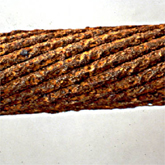What is Oxidation?
 The term 'oxidation' derives from the ancient observation of rust (oxide) formation. Early chemists could determine an increase in the weight of a metal as it apparently captured something from the air and transformed into a completely different material The 'something' was eventually identified as oxygen, and the new materials that formed were called 'oxides'. The chemical process came to be known as oxidation.
The term 'oxidation' derives from the ancient observation of rust (oxide) formation. Early chemists could determine an increase in the weight of a metal as it apparently captured something from the air and transformed into a completely different material The 'something' was eventually identified as oxygen, and the new materials that formed were called 'oxides'. The chemical process came to be known as oxidation.
The underlying transaction of oxidation was eventually identified as an alteration of the electronic structure of an element or compound. More accurately, this can be described as how strongly an atom 'owns' or controls the electrons around it. In an ion and ionic bonding, the atom controls its electrons completely, either by accepting them or by giving them up. In covalent bonding, an atom can be seen as sharing control of its electrons with another atom.
In oxidation, an atom loses control over a certain number of electrons to a material called an oxidizing agent. The loss of electrons by a chemical species is oxidation. Oxidation always occurs simultaneously with reduction. For example, the sulfide ion, S2-, can be easily oxidized to neutral sulfur atoms. To do this, each sulfide ion must give up ownership of two electrons to an oxidizing agent. In another example, the two carbon atoms of a carbon - carbon double bond lose control of two electrons in the reaction with an oxidizing agent to form two C - O bonds.
About the Author
Richard M J Renneboog, MS
 Richard M. J. Renneboog is an independent private technical consultant and writer in both chemical and computer applications. Endeavors have included preparation of scripts for instructional and promotional video, corporate website design, curriculum development for training in advanced composites technology, and development.
Richard M. J. Renneboog is an independent private technical consultant and writer in both chemical and computer applications. Endeavors have included preparation of scripts for instructional and promotional video, corporate website design, curriculum development for training in advanced composites technology, and development.


